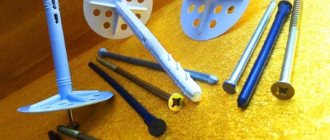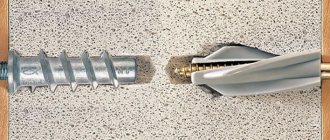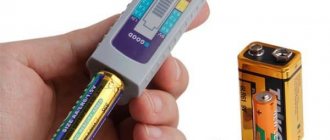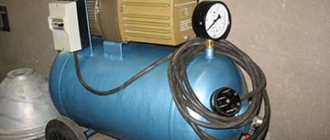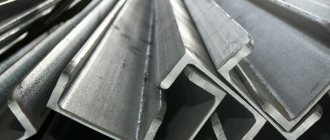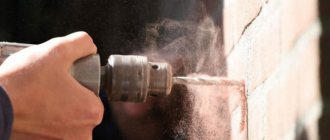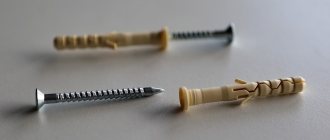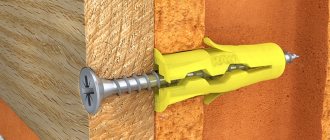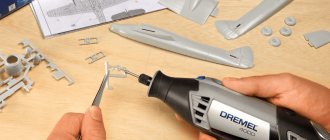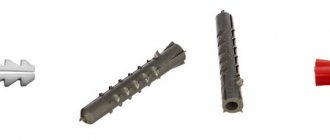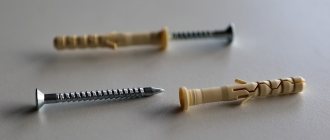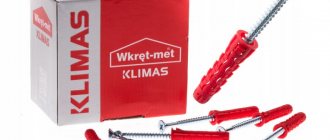Aerated concrete is often used in the construction of houses and other premises, so it is important to understand the technology for fastening dowels into aerated concrete. Due to the porous texture of aerated concrete, you need to carefully consider the fastening connection. On sale you can find special fasteners for aerated concrete. Please note that not all dowels can be attached to porous material. In this article, we will look at the features of dowels, the specifics of their fastening, and the key rules that should be followed when working with products.
Aerated concrete - what kind of material is it?
This is an affordable material suitable for the construction of houses and buildings. The main difference between aerated concrete is its porous structure, which is why it is considered fragile and easy to work with. You can easily cut the material to the desired configuration, trim it or trim it according to a template. Conventional dowels cannot be used because they cannot guarantee secure fastening.
In this case, only special dowels for aerated concrete are suitable. They differ from traditional ones in design. The bushing has a spiral shape with a grooved surface. The ribs located on the outside expand when screwed in. They easily fit into the loose structure, ensuring a reliable connection. This design can withstand heavy loads. Using dowels, you can attach cabinets, shelves, and decorative items to walls.
Tool and surface features
Installation tools:
- electric hand drill;
- drill bit with pobedite tip;
- hammer;
- a wrench or screwdriver for screwing in a screw;
- adhesive mixture for chemical anchor;
- special gun for glue mixture.
The main condition when installing objects and accessories is the correct choice of hardware.
Aerated concrete, having a porous structure, is a relatively fragile material, so the question arises - what kind of hardware is needed to ensure that the fastening is reliable and meets all the operating requirements of the structure.
There is a wide range of products that make it possible to fasten structures reliably and quickly.
From the video below you will learn about fasteners for aerated concrete.
What types of dowels are there?
All dowels differ in the shape of the ribs for fixation and the installation method. Dowels can be driven or screwed into the base. Screwing dowels into aerated concrete is considered the most reliable method. Let's look at the main types of fasteners that can be found on sale:
- Metal. For their production, galvanized steel is mainly used. The fasteners are highly fire resistant, can withstand heavy loads and are used for installing various pipelines. Metal dowels have a special collar that prevents rotation. The main disadvantage of metal dowels is the risk of corrosion. For aerated concrete, a metal dowel is suitable.
- Plastic. Made from durable materials that will not rust over the years. Mostly plastic products have ribs in the form of spirals. They provide a reliable connection to porous materials. Plastic dowels are environmentally friendly and can guarantee a strong fastening. Plastic is not exposed to aggressive factors, so dowels are quite common. The cost of plastic fasteners is an order of magnitude cheaper than their metal counterparts. Experts do not recommend plastic dowels for outdoor use due to their instability to temperature changes.
- Nylon. Such dowels, as well as plastic versions, are not subject to corrosion. The advantage of choosing nylon will be its strength and durability. Due to the relatively high cost, the demand for them is not so great. Most often, nylon dowels are used when installing doors, windows, and mirrors.
- Chemical. A special dowel for aerated concrete, which is used for installing large and heavy objects. Chemical anchors come to the rescue in cases where standard metal fasteners cannot cope with the task. When installing a chemical anchor, it is installed in the pilot hole with a special adhesive applied for more reliable fixation.
- Universal. Suitable for all types of surfaces, including porous aerated concrete. The design includes a spacer part. When immersing hardware, the universal dowel fixes it according to the principle of a standard expansion-type dowel.
- Gvozdeva. It is also called a dowel-nail. The structure provides for two struts without a toothed covering. When installing a nail dowel, you need to install a sleeve. It will prevent the hardware from scrolling. Anchor nails are budget fasteners designed for objects of insignificant weight. The main advantage is considered to be simple installation.
- Frame. There are models made of plastic and metal. Frame dowels are great for loose surfaces because they correctly distribute the load, which is mostly placed on the fastener itself.
- Thermal insulation. Most often used for fixing insulation. Suitable for working with concrete, brick and softer surfaces.
Types of fasteners and performance of work
The type of product is selected depending on the expected load:
- for fastening hanging mirrors or lamps, nylon dowels with a cross-section of up to 12 mm are suitable;
- when installing pipelines and bulky objects, choose metal parts;
- frame types of fastenings are used to fix window and door frames;
- universal facade dowels are used when installing external profiles for facing slabs;
- Only light objects are attached to wood screws - photo frames or decorative elements.
Installation is carried out in several stages.
In order for the products to fit tightly into the base, it is necessary to drill the holes correctly. To do this, it is best to use a hammerless drill or a hammer drill with the impact turned off. The drill should have a cross-section 1 mm smaller than the fastener itself. The only exception is steel hardware. For them, the hole will be reduced by 2 mm.
After cleaning the recess from concrete dust, install a dowel. The plastic fastener is screwed in using a screwdriver. Metal parts are driven into the mounting hole with a hammer. During the work, it is necessary to ensure that the product does not warp.
At the final stage, screw in a self-tapping screw or a standard mounting bolt. In this case, it is not advisable to use an electric tool, since when connecting to an aerated concrete block, the screw element may be damaged.
Which dowel for aerated concrete is better?
To choose the most suitable dowel from the options described above, pay attention to the following recommendations from experts:
- to fix mirrors, lamps and similar items, use nylon dowels;
- for outdoor work, choose metal fasteners;
- when installing large and heavy objects, metal dowels are better suited;
- for reliable facade connections - special fasteners made of durable plastic;
- when installing windows or doors, frame dowels will be a priority;
- to fix decorative objects, you can limit yourself to a regular nail without a dowel.
bik ton
Aerated concrete has proven itself as a building material, but it is porous and fragile, which makes it difficult to install household appliances and communication systems. Therefore, dowels for aerated concrete and anchors of various types are used to perform fastening work.
Dowels - their use for aerated concrete;
Types of anchors and features of their use;
Chemical anchors for aerated concrete;
Dowels – application for aerated concrete
In appearance, the dowel resembles an ordinary screw. The main purpose of dowels is to fasten various building structures to surfaces made of concrete, foam concrete, and hollow blocks. It is also advisable to use it in all places that are subject to increased fire safety requirements. For each type of surface, the corresponding types of screws are used: For drywall, chipboard, wood, etc. Design feature: it is made in the form of a non-expandable cylindrical neck and 4 spacer segments equipped with teeth on the sides.
To work with aerated concrete surfaces that have voids inside, specially designed dowels are used. Their design has its own specifics: a cylindrical neck with 4 spacer sections. Each of the spacers has specific serrated protrusions, which ensures fairly reliable fixation and prevents arbitrary unscrewing of the dowel. Depending on the properties of the material used for their production, there are three main types of dowels:
Each of these types of dowels finds its application depending on the magnitude of the loads and the intensity of operating conditions.
The use of metal dowels eliminates the need to pre-drill a hole for it: just hammer it into the wall. In cases with plastic or nylon dowels, you will have to pre-drill a hole for them. After the screw is screwed into the wall, the dowel segments expand into the base of the material. Additional reliability of fixing the dowel is ensured by the presence of cuts and serrated grooves.
In what cases is it possible to use a dowel? Yes, very different ones, for example:
When through fastening of door blocks or window frames is necessary;
Carrying out a variety of façade works;
Hanging shelves, cabinets, chandeliers, cornices, mirrors and other interior items inside the house;
During installation work on installing pipelines, plumbing, household electrical appliances, etc.
Types of anchors and features of their use
Please keep in mind: An anchor has its own differences from a dowel. This is a combined and independent fastening element. It is not just attached to the base - it must support the entire structure.
Due to the porous structure of aerated concrete, attention must be paid to fastening materials when installing air conditioners, fans of other household appliances, as well as air duct systems and hanging pipes. Typically these are anchors. Therefore, by choosing an anchor for aerated concrete that is suitable for the design characteristics, you can ensure greater strength in fixing the structure and provide additional reinforcement to the wall. Two types of anchors are used:
Installing dowels in aerated concrete: step-by-step guide
The principle of installing dowels in aerated concrete is practically no different from other surfaces. Focus on the following rules:
- It is important to make a pilot hole that matches the diameter of the dowel. It is important that the hole is smaller than the fastener. For example, for 10 mm fasteners you need to prepare a hole with a diameter of 9 mm.
- When working with a hammer drill, avoid impact mode. A drill is considered a more suitable tool.
- A screwdriver is suitable for screwing in the plastic dowel. With metal dowels, use a hammer.
- After installing the cuff all the way, proceed to screwing in the self-tapping screw.
Work order
Work algorithm:
- a hole of the required depth is drilled in the wall, its bottom is slightly expanded by oscillating movements of the drill;
- construction dust is blown out of the hole, and a sleeve is inserted into its neck;
- the cavity is filled with an adhesive solution using a mounting gun or capsules are installed here;
- an anchor rod is immediately inserted into it.
Marking for such fasteners must be done accurately and carefully, since it will be impossible to pull it out of the wall.
The nut and washer are installed after 2 days, when the mass has completely hardened.
Why are adhesives applied when installing dowels?
Adhesive mixtures are special compounds that are used to ensure the reliability of complex joints. Most of them contain epoxy resin, which has many properties. The scope of use of adhesive compositions includes fixing concrete elements and creating connections in complex technical structures.
The popularity of using special tools when working with dowels is due to the following factors:
- possibility of fastening in an aggressive environment, under the influence of moisture;
- intended for external fastenings without the risk of deformation and loosening of connections;
- eliminating stress in the dowel itself.
If you are faced with a complex design and think that an adhesive composition is needed to fix an object on an aerated concrete base, choose an option that is suitable for the price.
Options
To some extent, the characteristics and purpose of polyamide dowels are regulated by GOST 26998-86. To some extent, since fasteners are made from other materials, and also because GOST indicates only 2 possible diameters of the product - for a screw with a diameter of 4 and 5 mm. All other types of products are regulated by technical specifications or certified according to European rules, if we are talking about a foreign manufacturer.
The main technical characteristic of a dowel is its diameter, more precisely, the outer diameter corresponding to the size of the hole.
- Most often, the proposed size range includes 5, 6, 8, 10, 12, 14, 16 mm. Much less common, but there are dowels with a diameter of 4, 7 and 20 mm.
- The length of the product is usually not indicated. But here, a certain standardization of fasteners, tied to the standardization of the thickness of the fastened material and the base material, plays into the hands of builders. For example, a dowel with a diameter of 6 mm almost always has a length of 30 mm, and a fastener with a diameter of 8 mm has a length of 40 mm.
For special cases, elongated products are produced: Fischer and Sormat, for example, offer expansion dowels for bricks with longer lengths.
A feature of spacer plastic dowels for concrete is the ratio of the diameter of the sleeve and the diameter of the screw. The latter is not often included in the product, but is selected in accordance with exact requirements. Moreover, several screws correspond to a sleeve with a certain diameter.
The fact is that plastic is a material with good elasticity, and when screwing in a screw with a large diameter, the sleeve expands more, which provides a more reliable fastening.
| Dowel diameter and length, mm | Screw diameter, mm |
| 4*20 | 2– 3 |
| 5*25 | 3– 4 |
| 6*30 | 4–5 |
| 7*35 | 4,5–5,5 |
| 8*40 | 4,5– 6 |
| 10*50 | 6–8 |
| 12*60 | 8–10 |
| 14*70 | 10–12 |
| 16*80 | 12–14 |
| 20*100 | 16 |
The size range of metal fasteners is much more modest. In most cases, products are produced with a diameter of 6, 8 and 10 mm.
Products for aerated concrete are presented in almost the same standard sizes. As a rule, the maximum diameter and length are excluded, since the porous material is in any case not designed to attach too heavy structures to it.
- Dowels for concrete and aerated concrete with a diameter of 4 to 16 mm are made from nylon, since this material has the highest hardness with good viscosity.
- Fasteners made of polyethylene and polypropylene are usually limited to sizes from 5 to 10 mm.
Typical mistakes, fastening methods, recommendations when working with dowels
If you need to install a dowel in a loose aerated concrete surface, you should not use a screwdriver. If your tool has a speed control feature, that's good. Correctly calculate the diameter of the hole itself from the rule described above: the dowel must be larger than the hole. Otherwise, reliable fixation cannot be guaranteed.
The depth of the hole should be slightly larger than the dowel itself. Please note that dowels should only be used for their intended purpose. Despite their versatility and ease of installation, experts do not recommend using such products when installing large and heavy objects. Dowels are most suitable for solving small household tasks - attaching pictures, hooks and other objects.
It is allowed to use dowels for heavier weights, but subject to mandatory compliance with all rules. The information obtained will allow you to correctly determine the type of suitable fastener and avoid common mistakes.
When choosing fastenings for aerated concrete walls, take into account such features
When choosing hardware, take into account the strength of the working surface, the dimensions of the parts and their resistance to corrosion.
The higher the density of the material, the stronger the aerated concrete. This indicator sets the load limits on the fastener. Technical characteristics in digital terms are indicated on the packaging of building blocks after the letter D.
The strength of the connection is affected by the size of the dowels. Thus, when fixing massive structures, products of large diameters and lengths are used.
The resistance of fasteners to corrosion ensures the possibility of their use when installing external structures and arranging unheated premises.
Fastening building structures to aerated concrete
On such fragile walls it is necessary to fix not only wires and pipes, but also heavy structures: floors, roofing elements, etc. In such cases, fixing self-tapping screws into aerated concrete is not a solution; a serious decision is needed.
As a rule, it is carried out during the process of laying walls, when a monolithic reinforced concrete armored belt is made at the installation level of such structures. During pouring, studs and other embedded parts are installed into it, onto which the fastening is subsequently carried out.
If for some reason you did not make an armored belt, or did not provide mortgages in it, fastening is carried out only with chemical anchors.